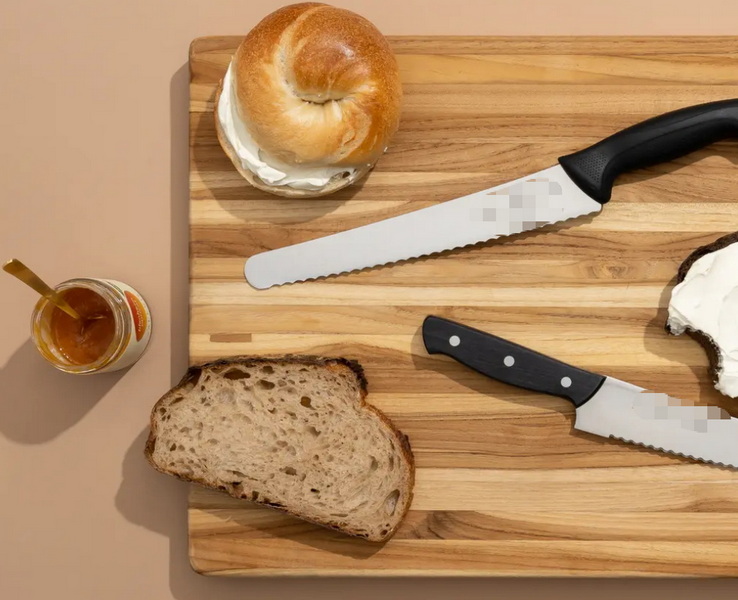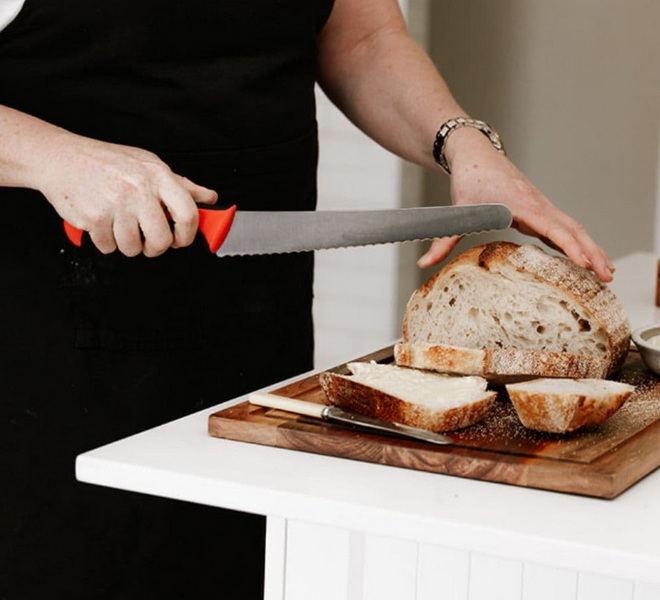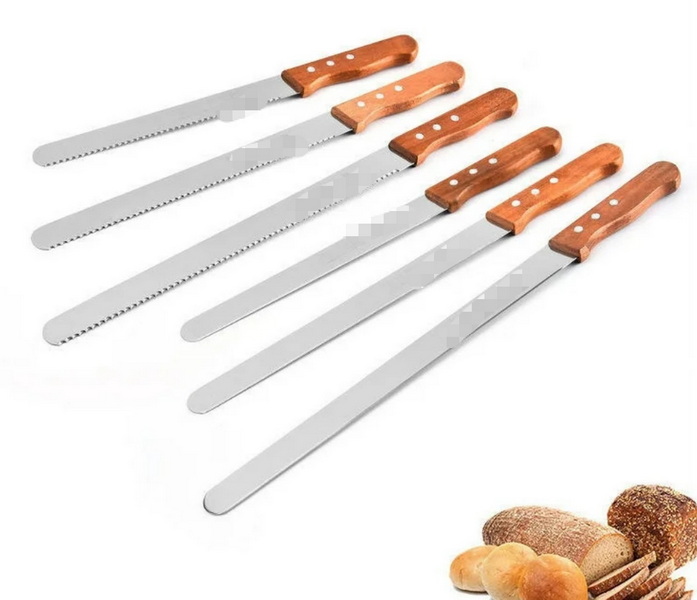- All
- Product Name
- Product Keyword
- Product Model
- Product Summary
- Product Description
- Multi Field Search
Views: 222 Author: Ann Publish Time: 2025-11-05 Origin: Site











Content Menu
● Best Bread Knives for Cutting Artisan Bread Without Crushing It
● Core Principles of a High-Performance Bread Knife
>> Serration and tooth profile
>> Blade material and edge retention
>> Handle design and ergonomics
>> Weight distribution and construction
>> Maintenance and care requirements
>> Suggested image and video ideas
● How to select a Bread Knife for OEM programs
● Industry applications and case considerations
● OEM collaboration and customization options
● Best practices for photography and videography for Bread Knife content
● SEO-focused content considerations
● FAQs
>> Question 1: What is the best blade length for artisan bread?
>> Question 2: Can a bread knife be used for non-bread foods?
>> Question 3: How should a Bread Knife be sharpened?
>> Question 4: Are bread knives dishwasher safe?
>> Question 5: What materials make the best Bread Knife?
Bread slicing is both an art and a science. A well-chosen Bread Knife can transform rustic loaves, sourdough boules, and airy artisanal breads into perfectly even slices without crushing the crumb. For brands that OEM kitchen tools for international markets, this guide explains how to evaluate Bread Knife performance, what blade and handle designs maximize efficiency, and how to pair visuals—images and videos—with compelling product storytelling. The Bread Knife is the central keyword, but readers will also encounter related terms such as serrated blades, blade length, edge retention, and ergonomic handles. This article is crafted to support OEM marketing, technical education, and strategic content creation for global distribution.

The headline highlights the core problem solved by the right Bread Knife: crusts stay crisp, interiors remain tender, and slices are uniform. For OEM programs, the choice of blade steel, tooth geometry, and mounting method matters not only for performance but for consistency across production batches and regional preferences. Readers include foreign brands, wholesalers, and manufacturers seeking reliable, scalable knife solutions. Bread Knife scenarios span crusty French baguettes, rustic sourdough, bakery loaves, and delicate sandwich loaves. The Bread Knife's job is to cut through crust without tearing the crumb, while maintaining user comfort and long service life.
A high-performance Bread Knife combines precise blade geometry with durable materials and ergonomic design. The following elements are foundational for OEM success:
- Blade geometry and blade length
- Tooth profile and serration
- Blade material and edge retention
- Handle design and ergonomics
- Weight distribution and balance
- Construction quality and corrosion resistance
- Maintenance and care requirements
Standardizing these factors across production lines reduces variability, improves sourcing efficiency, and ensures consistent user experience across markets. Price alone cannot guarantee performance; repeatable manufacturing, reliable materials, and robust QA are essential for global OEM partnerships.
- Typical lengths range from 8 to 10 inches (20–25 cm). Longer blades cover more loaf with fewer strokes, reducing crumb tearing and crumb damage in artisanal breads.
- A slight taper and a blade that remains stiff yet responsive improves control when slicing through thick crusts.
- In OEM programs, selecting a standardized blade geometry ensures uniform performance across batches and simplifies supplier qualification.
- For specialty markets, consider offering two standard lengths with clearly defined tolerances and interchangeable blade modules to support regional preferences.
- Serrated edges saw through crusty exteriors with minimal resistance, while snagging crumbs rather than tearing them.
- Scalloped versus pointed serrations offer different cutting behaviors: scalloped edges can reduce bite marks on the crust and enable longer, smoother slices.
- The quality of serrations and sharpening intervals impact maintenance costs and blade life in high-volume environments.
- For OEM, define a serration pitch and tooth geometry that align with target bread types (crust-heavy loaves vs. soft-centered breads) and ensure repeatable production tolerances.
- Common materials include high-carbon stainless steels and German stainless variants, chosen for hardness, corrosion resistance, and edge retention.
- Some premium lines explore alloying strategies or alternative steels to optimize wear resistance without sacrificing toughness.
- For coastal or high-humidity markets, include corrosion resistance as a core specification in material selection.
- In OEM negotiations, provide a clear material specification chart with Rockwell hardness targets, heat-treatment windows, and post-processing steps to guarantee uniform edge performance.
- Ergonomic, slip-resistant handles improve safety and efficiency in busy kitchens and bakeries.
- Full tang construction enhances balance and durability under heavy daily use and frequent washing.
- Handle material choices should consider chemical resistance from cleaners, heat exposure, and color branding options for product lines.
- For marketing materials, ensure shots emphasize comfort, grip texture, and how the handle harmonizes with the blade's weight distribution.
- A well-balanced Bread Knife reduces wrist fatigue during extended slicing sessions.
- Precise fit between blade, tang, and handle minimizes creaks and looseness after repeated washings in commercial environments.
- OEM suppliers should specify tightening tolerances and quality checks for joint integrity and blade straightness.
- Most Bread Knives benefit from hand washing to preserve edge life and handle integrity; dishwasher exposure can accelerate wear in some models.
- Provide maintenance guidance tailored to the chosen blade steel, including honing versus sharpening intervals, and recommended sharpening tools or services.
- Communicate clear care instructions in product manuals and regional localizations to support end-users and food-service partners.
- A top-down shot of the Bread Knife cutting through a crusty loaf, with a clear crust crack pattern.
- A side view showing edge contact with the bread, emphasizing minimal crumb crushing.
- Macro shots of serrations biting into crust and the blade's finish.
- Short clips showing rapid, clean slices in a bakery setting.
- A care-and-maintenance video depicting washing, drying, and light sharpening steps.
- Lifestyle shots showing chefs or bakers using the knife in real kitchen environments to convey practicality and durability.

- Define target markets and typical bread types to bake, then specify blade length and serration to match those loaves.
- Choose blade materials with consistent supply chains and post-processing standards across production runs.
- Ensure handle materials and ergonomics align with global user preferences and food-safety requirements.
- Establish standardized QA checks for edge sharpness, serration pitch, and blade hardness.
- Plan for image and video production that highlights key features while remaining cost-effective for large campaigns.
- Develop modular packaging options that accommodate logo customization, color branding, and regional regulatory labeling.
- Bakeries producing sourdough or rustic loaves benefit from serrated blades that minimize crumb damage while delivering consistent slices.
- Culinary schools and hotel kitchens appreciate durable, easy-to-clean handles and robust edge life for high-volume use.
- Brand partners value consistent supply and customization options, such as logo etching, color handles, or specialty packaging.
- For OEM collaborations, outline scalable production workflows, including stamping vs. forging choices, heat treatment schedules, and surface finishing options that impact appearance and longevity.
- Branding: laser etching, printed packaging, and color accents on handles.
- Materials: steel grade, coating options, and handle composition to meet regional preferences and safety standards.
- Packaging: blister packs, gift sets, or chef-case packaging designed for retail or wholesale channels.
- Documentation: product manuals, maintenance guidelines, and safety notes in multiple languages for global markets.
- Quality control: tolerance specs for blade straightness, serration pitch, and handle fit, ensuring uniform performance across batches.
- Warranty and after-sales: define coverage, service networks, and replacement parts to reassure international buyers.
- Use consistent lighting to reveal blade finish and edge sharpness.
- Shoot at multiple angles: top-down for slicing action, side profiles for balance, and macro views of serrations.
- Include bread crumb textures and crust coloration for visual interest.
- Caption images with the Bread Knife's key features and practical use cases.
- Produce short, informative clips (5–15 seconds) demonstrating cutting technique, cleaning, and maintenance.
- Create product videos that highlight regional use scenarios, such as bakery counters in Europe, hotels in North America, and street markets in Asia, to broaden appeal.
- Primary keyword: Bread Knife appears throughout the article with varied sentence structures to maintain readability and search relevance.
- Secondary terms: serrated bread knife, edge retention, blade material, ergonomic handle, professional bread knife, artisan bread slicing.
- On-page elements: descriptive meta title, meta description, header structure with H1/H2/H3 tags, alt text for all images, and internal links to related product guides.
- Structured data: consider adding product schema markup for OEM bread knife offerings to improve rich results in search engines.
A high-performance Bread Knife is a critical tool in the kitchen toolkit, capable of turning crusty artisanal breads into perfect slices with minimal crumb damage. For OEM manufacturers, selecting blade geometry, serration, materials, and ergonomic handling that align with global market needs ensures repeatable quality across diverse client bases. Coupling compelling imagery and videos with well-structured content enables brands to connect with wholesalers and end users worldwide. A strategic combination of product excellence and media storytelling strengthens market positioning and drives demand for Bread Knife solutions across regions. If a partner seeks customization, turnaround times, branding options, and media-ready content packages tailored to regional markets, initiate a conversation to explore how to embed these capabilities into an OEM program.

Answer: For most artisan loaves, a 9-inch blade provides a balance of reach and control, enabling clean, even slices without excessive wrist movement. This length is widely adopted by leading bread-knife lines and offers compatibility with a broad range of loaf sizes, making it a reliable default for OEM programs.
Answer: Yes, bread knives can slice tomatoes, cakes, and soft cheeses, but serration behavior varies. For delicate tasks, some users prefer a dedicated non-serrated or lightly serrated blade to preserve blade longevity, while still leveraging the bread knife for tougher crusts when appropriate.
Answer: Start with a light honing to maintain edge alignment, then resharpen with a sharpening stone or a professional sharpening system appropriate to the blade's steel. Avoid aggressive metal removal to preserve blade life, and follow manufacturer guidelines for angle and pressure to maintain serration integrity.
Answer: Hand washing is generally recommended to preserve edge life and handle integrity, especially in professional settings where long-term durability matters. If a dishwasher is used, ensure the knife is placed securely to avoid contact with other utensils and use a gentle cycle with mild detergent.
Answer: High-carbon stainless steel offers good edge retention and corrosion resistance, combined with an ergonomic handle and a robust construction for reliable performance in professional kitchens and for OEM customers. Material choice should consider regional climates, maintenance capabilities, and supply chain stability.
The Ultimate Professional Knives for Halal Butchery in Middle Eastern Kitchens
Chef Knife Size Guide: Choosing Between 6″, 8″, 10″, And 12″
Custom Knife Handles: How To Design A Chef Knife That Fits Your Hand Perfectly
Chef Knife Surface Treatments Guide: From Polished Migaki To Damascus Patterns
Inside Our Professional Knife Sample Room: Quality You Can See
Universal Knife Block Buying Guide: Modern Acrylic & ABS Knife Holders for Professional Kitchens
Universal Knife Block: The Complete Guide To Modern, Hygienic Knife Storage
The Complete Guide To Red Handle Knife Sets: Style Meets Functionality in The Kitchen
Professional Knives for Halal Butchery And Middle Eastern Cuisine